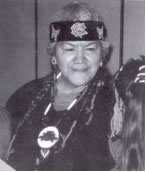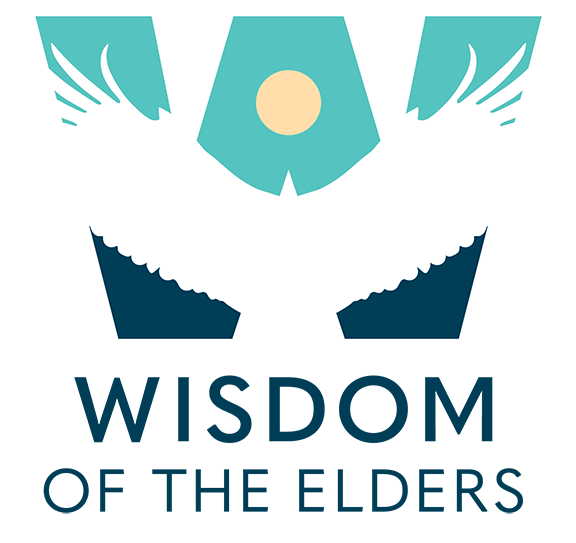Let Them Stay
( Speaks in Language)
 To interpret what I said is merely an introduction. Hello, my friends and relatives. I’m happy to be here today and my name is Pauline Hillaire and I come from the Lummi Nation.
To interpret what I said is merely an introduction. Hello, my friends and relatives. I’m happy to be here today and my name is Pauline Hillaire and I come from the Lummi Nation.
Today I’d like to share with everyone that I am a storyteller. I am a historian. I’m a genealogist and I tell legends in schools and teach Indian songs to the kids to pass it on. It’s time for sharing. One of the things I do talk about in schools is the true stories – especially from the government documents. These documents have a way of telling the truth in such a stoic way that something funny can come across as a serious document. This is one story like that. It’s about long long long ago – long before the signing of the peace treaty of 1865. There was a president by the name of Buchanan who’s also governor of Pennsylvania. He ordered governor Isaac I. Stevens of the Washington territory to remove all the Indians from the fishing sites. There are so many here on the coast that for fishing sites to across the mountains. To Wenatchee or Yakima. We would join the Indians there. So he took it upon himself for these four units of soldiers and drove us from our fishing sites to the mountains. Well, we were so familiar with the mountains that we led the way to where they wanted to place us in custody over there on the other side of the mountains. He did his best and rounded up the fishermen and brought them to the mountains and across the mountains. They lost their way and they were having such a horrible time with hunger. Then the Indians saved the day by showing where to go and show them what to eat and then placing them in an encampment across the mountains. Well, just as soon as the soldiers fell asleep the Indians escaped and came back home and beat the soldiers back here and then went fishing again. Well, the soldiers finally came straggling back and then they looked at these fishing sites again, and there they were the same people that they had driven across the Cascade Mountains. They just wondered to themselves, now what? They rounded them up again and they headed back to the Wenatchee/Yakama area. The Indians helped them find their way and helped them find things to eat. They went across the mountains and put the Indian people in the encampment and then the third time it happened exactly like it did the first and the fourth time it happened exactly like it did on the first trip. So governor Isaac I. Stevens records this letter in the government documents. It’s getting rather expensive to transport these people to the Wenatchee/Yakama areas for them to stay there. He said these people have permanent homes. They have canoes for every body of water. They have nine kinds of fish they have 26 kinds of berries. They have clothes for every season. They are well established. We might as well leave them here because it is getting expensive to transport them to the Wenatchee/Yakama area. So Buchanan wrote back and he said, Well, let them stay. So it is today we are here on the coast and not with the Wenatchee or Yakama tribes.
Pauline Hillaire
Pauline Hillaire of Bellingham, Washington belongs to the Lummi Nation. Her lineage can be traced back eleven generations on her mother’s side and ten generations on her father’s side. Research on the family lineage began in 1961 and is an ongoing project. Her father, Joe Hillaire, was well known for his carving of totem poles and his oratory.
Lummi is a derivative of the words Noohwalulumo and Kwelummi according to government documents. The different names represented the different areas of the Lummi people. They originally occupied the many islands of the San Juan Island chain. They were relocated to the Washington shoreline directly across from the San Juan Islands. This area was heavily wooded with big old-growth cedar. Unfortunately, there was fire, the big burn’ of 1868, and the forest burned. This area was very valuable to the Lummi people. The cedars provided logs that were used for canoes, homes, storage boxes, and cooking boxes. Large burnt stumps can still be seen, but the cedar is starting to come back. Today the terrain is quite flat with small mounds or hills. When the rainy season and the snow melting season come the Lummi Nation becomes an island.
Pauline is a historian, storyteller and genealogist. Her father passed legend stories to her that he told as he carved a totem pole. She can derive what kind of pole it is; discern whether it’s a story pole, history pole, genealogy pole, an object pole or a person pole. She tells stories about where Sasquatch lived and how some women fed him, stick Indians, and the little people. Her history stories relate to her grandfather, Frank Hillaire, and her father, Joe, and how they bridged the cultural vacancy after the government had outlawed the gathering of the people for their canoe races. The races were for fitness and self-esteem. The victorious racers were known up and down the coast.
Other topics Pauline discusses in her presentations include tribal dances and music; paddle song, blanket song, wolf dance and whale dance. Every object in a legend has a song, every legend has a song and every song had a legend. There are not many cultural artifacts left because of the fire and transfer from the San Juan Islands. One artifact that is left is called the cho-its-oot post. The Lummi were mostly basket weaving and woodcarving people. They were also introduced to beading.
Pauline will include discussions on health and healing, tribal government, and tribal politics. Due to population growth and land occupation, a lot of herbs and teas have been destroyed. The tribal government didn’t start until about 1920.
Additionally Pauline talks about river travel. Long ago in the treaty days people had little ferries, little canoes, that would take the white people across the river (?) and there were small businesses similar to those up and down the Big Nooksack River.
Pauline just finished the Grandmother’s International Gathering, which is a once-in-a-lifetime event. She was awarded the Washington Governor’s Heritage Award in 2004. She’s a member of the Seattle Folk Life Council and the Setting Sun Dance Group. Black Dog Production of Bellingham, Washington made a video of the Grandmother’s gathering. She published a book titled Indian Policy: Crime or Reason’ in 1973 which was based on government documents. She has been videotaped by various organizations such as the Samish tribe, the Library at the University of Washington, the Bellingham Centennial. She started out giving presentations to school systems traveling over to Montana down to California up to Bella Bella, Canada, that’s just a stone’s throw to the Alaskan Pan Handle.
Pauline Hillaire
3242 Balch Rd
Bellingham, WA 98226 360-758-2570
Pauline_hillaire@all2easy.net
